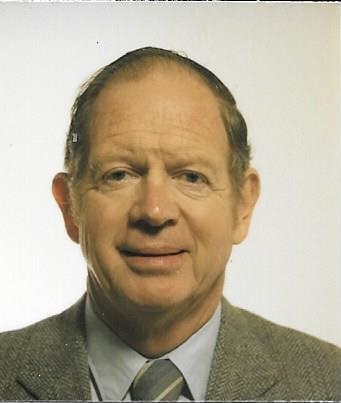

|

|
IN MEMORIAM
Thomas Lofton Allen
Professor Emeritus of Chemistry
UC Davis
1924—2015
Thomas Lofton Allen, professor emeritus of chemistry at the University of California, Davis, died peacefully in his sleep on June 28, 2015 at his home in Davis, California, at age 91. The son of Glenn Loring Allen and Emma Blanchard Allen, he was born in San Jose, California, on January 20, 1924. He grew up on a fruit ranch near Santa Clara, and graduated from Santa Clara High School. In February 1944 he received the B.S. degree in Chemistry with Honors from the University of California, Berkeley.
Through the Naval ROTC program at UC Berkeley Tom received a commission as Ensign in the U.S. Naval Reserve. Following submarine schools in San Diego, California, and New London, Connecticut, he was assigned as an officer to the USS Bluefish (SS-222) in late 1944. He completed three successful war patrols during 1945 on the Bluefish in the Western Pacific Ocean, and was promoted to Lieutenant (junior grade).
Following World War II he attended the California Institute of Technology in Pasadena where he received the Ph.D. degree in Chemistry in 1949. Professor Donald M. Yost was his research supervisor. His first teaching position was as an Assistant Professor of Chemistry at the University of Idaho, Moscow, during 1948-49. He then joined the faculty at the University of California, Davis, where he was promoted through the ranks to Professor of Chemistry in 1963 and remained until his retirement in 1993. After he retired he continued to be active in research for another ten years.
Professor Allen’s main fields of teaching and research were Inorganic Chemistry and Physical Chemistry. Early interests were the kinetics of electron transfer reactions in solution, isotope effects on reaction rates (with Dr. Jacob Bigeleisen at Brookhaven National Laboratory), and the chemistry of metallic halides. His long-term interest in chemical bonding led to studies of the apparent variations in the energies of chemical bonds, shown to be caused by second-order interactions of next-nearest neighbors. This work led to an analysis, with Professor Harrison Shull at Indiana University, which showed how the classical chemical bond is the natural result of the quantum-mechanical interactions of the electrons and nuclei in a molecule. Later studies utilized computers to model various small molecules and transition states. This work was done in collaboration with Professor Henry F. Schaefer at UC Berkeley, and later with his colleagues William H. Fink and Phillip P. Power, at UC Davis. While on a sabbatical leave at the University of Nottingham in England, he worked with Professor George G. Hall on the application of the Monte Carlo method to solving the Schrödinger equation for the helium atom.
Always very interested in teaching, Professor Allen regularly taught the introductory courses in general and analytical chemistry, the junior-level courses in inorganic chemistry and physical chemistry, and a graduate course in quantum chemistry. He and his friend and colleague at Davis Professor Raymond M. Keefer coauthored a general chemistry textbook, “Chemistry: Experiment and Theory,” first published in 1974.
Honors included selection by the students as the Picnic Day Parade Marshal in 1976; the first Magnar Ronning Award for Teaching Excellence in the Sciences, presented by the Associated Students of UC Davis in 1977; and Marshal of the 1997 College of Letters and Science Commencement. He was a member of the American Chemical Society, the Society of Sigma Xi, U. S. Submarine Veterans of World War II, and the Sierra Club.
The UC Davis Academic Senate was a major activity of Dr. Allen for many years. In 1969-70 he served as Chairperson of the University-wide Committee on Educational Policy, where he led a successful fight against the imposition of tuition fees on UC students. At various times he served as Chair of the Davis Division, Chair of the Davis Division’s Committee on Academic Personnel, and as a member of the Committee on Budget and Interdepartmental Relations. He also served as Chair of the Faculty of the College of Letters and Science and Chair of the College’s Special Committee on the Educational Process.
In July 1944 Tom married the love of his life, Patricia Eileen Powers, whom he met when they were undergraduates at UC Berkeley. His main interest was always his family. They spent considerable time enjoying camping and hiking together in the Sierras, particularly in the Yosemite area. In spite of his muscle weakness from a case of polio in 1950, he and his wife climbed Mt. Hoffman and Vogelsang Peak, ascended the Mist Trail, and reached Hanging Basket Lake near Vogelsang. He was also an avid cyclist and on two occasions he completed the 100 km event of the Davis Bike Club’s Fall Century. Other hobbies included travel, reading, music, gardening and photography. In 2013 Dr. Allen published a book of memoirs, “Growing up in the Santa Clara Valley-From Picking Prunes to Submarine Service”.
In addition to his wife of 70 years Patricia, Tom’s survivors include their children Kathleen Rodgers of Nelson, British Columbia; Tim Allen and his wife Shona of Medford, Oregon; Jacquelyn and her husband John Trautt of Long Beach, California; Diana Kay, the widow of their son Keith (who died in 2004 at age 50) of Woodstock, Vermont; Keith's former wife Jane Allard Allen of Petaluma, California; sixteen grandchildren and eight great grandchildren. He was predeceased by a sister, Peggy Steacy, of Cupertino, California and brothers Glenn Loring Allen, Jr., of Walnut Creek, California; Judge Bruce F. Allen of Los Gatos, California; and Kenneth L. Allen, M.D., of Hillsborough, California.
Edwin C. Friedrich, chair
George S. Zweifel
William H. Fink